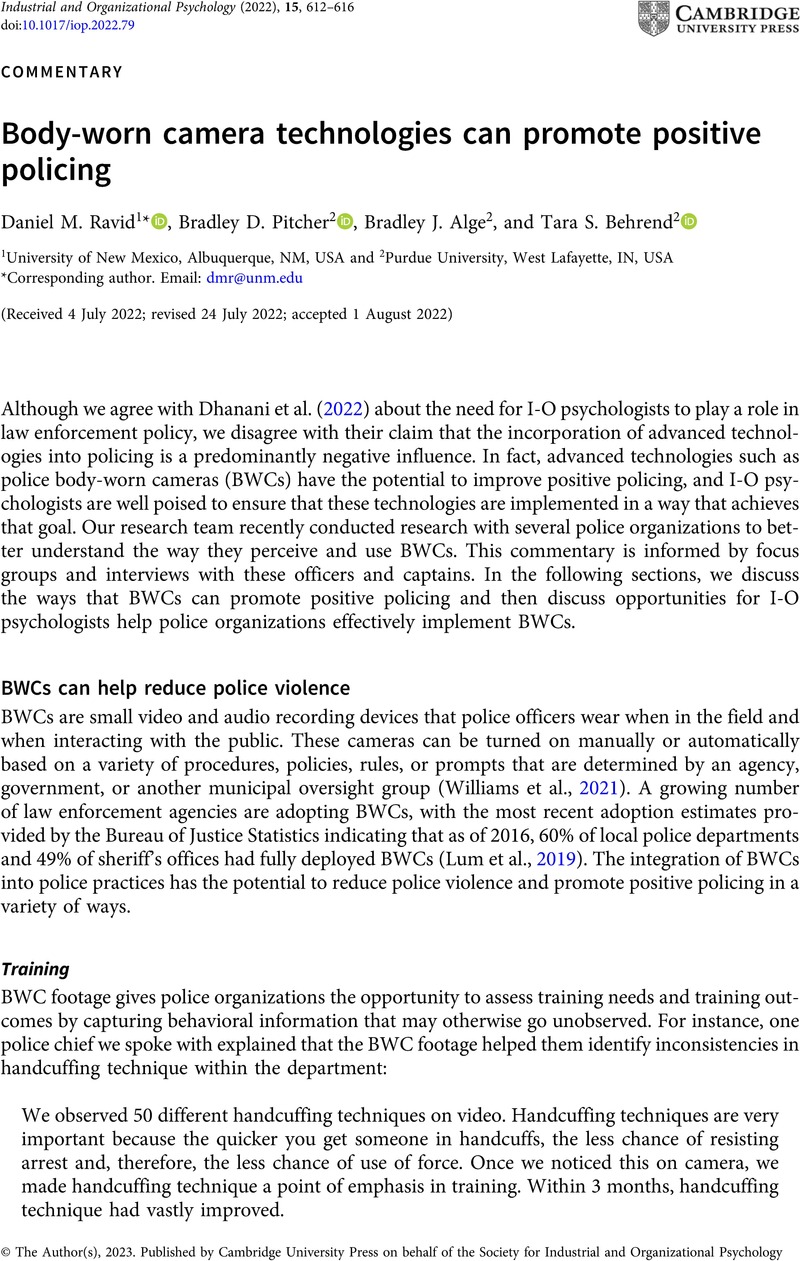No CrossRef data available.
Article contents
Body-worn camera technologies can promote positive policing
Published online by Cambridge University Press: 27 January 2023
Abstract
An abstract is not available for this content so a preview has been provided. Please use the Get access link above for information on how to access this content.

- Type
- Commentaries
- Information
- Copyright
- © The Author(s), 2023. Published by Cambridge University Press on behalf of the Society for Industrial and Organizational Psychology
References
Aguinis, H., & Kraiger, K. (2009) Benefits of training and development for individuals and teams, organizations, and society. Annual Review of Psychology, 60, 451–474. https://doi.org/10.1146/annurev.psych.60.110707.163505
CrossRefGoogle ScholarPubMed
Bisbey, T. M., Grossman, R., Panton, K., Coultas, C. W., & Salas, E. (2021) Design, delivery, evaluation, and transfer of effective training systems. In Salvendy, G. & Karwowski, W. (Eds.), Handbook of human factors and ergonomics (1st ed., pp. 414–433). Wiley. https://doi.org/10.1002/9781119636113.ch16
CrossRefGoogle Scholar
Dahl, Y., Alsos, O. A., & Svanæs, D. (2010) Fidelity considerations for simulation-based usability assessments of mobile ICT for hospitals. International Journal of Human-Computer Interaction, 26(5), 445–476. https://doi.org/10.1080/10447311003719938
CrossRefGoogle Scholar
DeNisi, A. S., & Kluger, A. N. (2000) Feedback effectiveness: Can 360-degree appraisals be improved? Academy of Management Perspectives, 14(1), 129–139. https://doi.org/10.5465/ame.2000.2909845
CrossRefGoogle Scholar
Dhanani, L. Y., Wiese, C. W., Brooks, L., & Beckle, K. (2022) Reckoning with racialized police violence: The role of I-O psychology. Industrial and Organizational Psychology: Perspectives on Science and Practice, 15(4), 554–577.CrossRefGoogle Scholar
Gaub, J. E., & White, M. D. (2020) Open to interpretation: Confronting the challenges of understanding the current state of body-worn camera research. American Journal of Criminal Justice, 45(5), 899–913. https://doi.org/10.1007/s12103-020-09518-4
CrossRefGoogle Scholar
Jennings, W. G., Fridell, L. A., & Lynch, M. D. (2014) Cops and cameras: Officer perceptions of the use of body-worn cameras in law enforcement. Journal of Criminal Justice, 42(6), 549–556. https://doi.org/10.1016/j.jcrimjus.2014.09.008
CrossRefGoogle Scholar
Landers, R. N., & Marin, S. (2021) Theory and technology in organizational psychology: A review of technology integration paradigms and their effects on the validity of theory. Annual Review of Organizational Psychology and Organizational Behavior, 8(1), 235–258. https://doi.org/10.1146/annurev-orgpsych-012420-060843
CrossRefGoogle Scholar
Lawshe, N. L., Burruss, G. W., Giblin, M. J., & Schafer, J. A. (2019) Behind the lens: Police attitudes toward body-worn cameras and organizational justice. Journal of Crime and Justice, 42(1), 78–97. https://doi.org/10.1080/0735648X.2018.1554839
CrossRefGoogle Scholar
Liu, D., Macchiarella, N. D., & Vincenzi, D. A. (2008) Simulation fidelity. In Vincenzi, D. A., Wise, J. A., Mouloua, M., & Hancock, P. A. (Eds.), Human Factors in simulation and training (pp. 61–74). CRC Press. https://doi.org/10.1201/9781420072846.ch4
CrossRefGoogle Scholar
Lum, C., Koper, C. S., Wilson, D. B., Stoltz, M., Goodier, M., Eggins, E., Higginson, A., & Mazerolle, L. (2020) Body-worn cameras’ effects on police officers and citizen behavior: A systematic review. Campbell Systematic Reviews, 16(3), Article number: e1112.CrossRefGoogle Scholar
Lum, C., Stoltz, M., Koper, C. S., & Scherer, J. A. (2019) Research on body-worn cameras: What we know, what we need to know. Criminology & Public Policy, 18(1), 93–118. https://doi.org/10.1111/1745-9133.12412
CrossRefGoogle Scholar
Machin, M. A., & Fogarty, G. J. (2003) Perceptions of training-related factors and personal variables as predictors of transfer implementation intentions. Journal of Business and Psychology, 18(1), 51–71. https://doi.org/10.1023/A:1025082920860
CrossRefGoogle Scholar
Northcraft, G. B., Schmidt, A. M., & Ashford, S. J. (2011) Feedback and the rationing of time and effort among competing tasks. Journal of Applied Psychology, 96(5), 1076–1086. https://doi.org/10.1037/a0023221
CrossRefGoogle ScholarPubMed
Posthuma, R. A., Charles Campion, M., & Campion, M. A. (2018) A taxonomic foundation for evidence-based research on employee performance management. European Journal of Work and Organizational Psychology, 27(2), 168–187. https://doi.org/10.1080/1359432X.2018.1438411
CrossRefGoogle Scholar
Ravid, D. M., Tomczak, D. L., White, J. C., & Behrend, T. S. (2020) EPM 20/20: A review, framework, and research agenda for electronic performance monitoring. Journal of Management, 46(1), 100–126. https://doi.org/10.1177/0149206319869435
CrossRefGoogle Scholar
Ravid, D. M., White, J. C., Tomczak, D. L., Miles, A. F., & Behrend, T. S. (2022) A meta-analysis of the effects of electronic performance monitoring on work outcomes. Personnel Psychology. https://doi.org/10.1111/peps.12514
CrossRefGoogle Scholar
Salas, E., Martin, L., & Flin, R. (2016) Decision-making under stress: Emerging themes and applications. Routledge. https://doi.org/10.4324/9781315258409
Google Scholar
Salas, E., Wildman, J., & Piccolo, R. (2009) Using simulation-based training to enhance management education. Academy of Management Learning and Education, 8(4), 559–573. https://doi.org/10.5465/AMLE.2009.47785474
Google Scholar
Schleicher, D. J., Baumann, H. M., Sullivan, D. W., Levy, P. E., Hargrove, D. C., & Barros-Rivera, B. A. (2018) Putting the system into performance management systems: A review and agenda for performance management research. Journal of Management, 44(6), 2209–2245. https://doi.org/10.1177/0149206318755303
CrossRefGoogle Scholar
Stanton, J. M. (2000) Traditional and electronic monitoring from an organizational justice perspective. Journal of Business and Psychology, 15(1), 129–147. https://doi.org/10.1023/A:1007775020214
CrossRefGoogle Scholar
Thayer, P., & Teachout, M. S. (1995) A climate for transfer model. AL/HR-TP-1995-0035, Texas: Brooks Air Force Base.Google Scholar
Tomczak, D. L., Lanzo, L. A., & Aguinis, H. (2018) Evidence-based recommendations for employee performance monitoring. Business Horizons, 61(2), 251–259. https://doi.org/10.1016/j.bushor.2017.11.006
CrossRefGoogle Scholar
Williams, Morgan C. Jr., Weil, N., Rasich, E. A., Ludwig, J., Chang, H., & Egrari, S. (2021) Body-worn cameras in policing: Benefits and costs (Working Paper No. 28622; Working Paper Series). National Bureau of Economic Research. https://doi.org/10.3386/w28622
CrossRefGoogle Scholar
Willits, D. W., & Makin, D. A. (2018) Show me what happened: Analyzing use of force through analysis of body-worn camera footage. Journal of Research in Crime and Delinquency, 55(1), 51–77. https://doi.org/10.1177/0022427817701257
CrossRefGoogle Scholar




